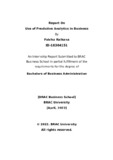| dc.contributor.advisor | Shuvo, Mr. Shihab Kabir | |
| dc.contributor.author | Raihana, Fabiha | |
| dc.date.accessioned | 2023-05-10T08:12:07Z | |
| dc.date.available | 2023-05-10T08:12:07Z | |
| dc.date.copyright | 2022 | |
| dc.date.issued | 2022-04 | |
| dc.identifier.other | ID: 18304151 | |
| dc.identifier.uri | http://hdl.handle.net/10361/18266 | |
| dc.description | This internship report is submitted in partial fulfillment of the requirements for the degree of Bachelor of Business Administration, 2022. | en_US |
| dc.description | Cataloged from PDF version of internship report. | |
| dc.description | Includes bibliographical references (page 66). | |
| dc.description.abstract | The practice of gathering and evaluating behavioral customer data from a
variety of channels, devices, and interactions is known as predictive
analytics. These analytics provide the knowledge required to create
strategies, goods, and services that your clients will be interested in using.
The company may need to employ strategies like data gathering and
segmentation, modeling, data visualization, and more for all kinds of
consumer analytics. Any business should put its customers first. Businesses
have implemented customer relationship management systems to
enhance procedures involving client engagement. These systems gather a
lot of consumer data, which is significant information that can help a
company improve customer interactions and offerings. Customer analytics
typically concentrate on recording what has occurred. However, it's critical
to foresee what customers will want and how they will respond in order to
be proactive and actually create a company's future. Any firm must have
a thorough understanding of its customers as well as how its operations
have fared in the past, present, and future. My assigned division
Enterprise Business Solutions is continuously focusing on improving their
customer relationship more utilizing technology. This study involves how
they can do it more effectively using predictive customer analytics. | en_US |
| dc.description.statementofresponsibility | Fabiha Raihana | |
| dc.format.extent | 66 pages | |
| dc.language.iso | en | en_US |
| dc.publisher | Brac University | en_US |
| dc.rights | Brac University internship reports are protected by copyright. They may be viewed from this source for any purpose, but reproduction or distribution in any format is prohibited without written permission. | |
| dc.subject | Machine learning | en_US |
| dc.subject | Predictive analytics | en_US |
| dc.subject | CRMS | en_US |
| dc.subject | ICT solutions | en_US |
| dc.subject | Techno- commercial | en_US |
| dc.subject | Data analysis | en_US |
| dc.subject.lcsh | Business forecasting--Mathematical models. | |
| dc.subject.lcsh | Business forecasting--Data processing. | |
| dc.title | Use of predictive analytics in Business | en_US |
| dc.type | Internship report | en_US |
| dc.contributor.department | Brac Business School, Brac University | |
| dc.description.degree | B. Business Administration | |

